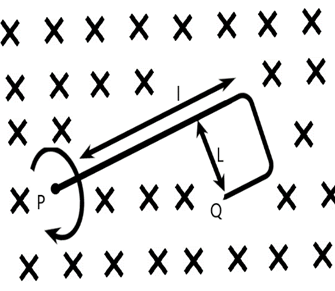
When a $'J'$ shaped conducting rod is rotating in its own plane with constant angular velocity $\omega $, about one of its ends $P$, in a uniform magnetic field $B$as shown then the magnitude of induced emf across it will be

A. $B\omega = \sqrt {{L^2} + {l^2}} $
B. $\dfrac{1}{2}B\omega {L^2}$
C. $\dfrac{1}{2}B\omega ({L^2} + {l^2})$
D. $\dfrac{1}{2}B\omega {l^2}$
Answer
217.2k+ views
Hint: When a bar magnet is moved into and out of the coil, an emf is produced in the coil. Motion in opposing directions results in emfs of the opposite signs, and reversing the poles will likewise reverse the emfs. The same outcomes are obtained by moving the coil rather than the magnet.
Complete step by step solution:
In the question, a $J$ shaped conducting rod is rotating in its plane with constant velocity $(\omega )$, the end point of the rod is $P$ in a uniform magnetic field $(B)$. Calculating the EMF of the two lengths of the conductor separately. Let displacement of $PQ$ be $x$, $\omega $ be the velocity and $dx$be small displacement along the length $l$ of the conductor, then the emf induced in the small element due to its motion is given by:
$De = B\omega xdx$
Integrate the aforementioned equation within the appropriate bounds to determine the net induced emf.
$\int\limits_0^e {De = \int\limits_0^l {B\omega xdx} }\\ $
$\Rightarrow e = B\omega [\dfrac{{{x^2}}}{2}]_0^l$
Apply the limit on the integrated equation, to determine emf induced between the centre of the rod and one of its side is, so the limit extends from:
$e = B\omega [\dfrac{{{l^2}}}{2}] - B\omega [\dfrac{{{0^2}}}{2}] \\$
$\Rightarrow e = B\omega [\dfrac{{{l^2}}}{2}]\,\,\,.....(i) \\$
The effective length of the circular path we took will be determined similarly. Since the falling object is a ring the projection of length of the ring along the length $L$ of the conductor,
$\int\limits_0^e {De = \int\limits_0^L {B\omega xdx} } \\ $
$\Rightarrow e = B\omega [\dfrac{{{x^2}}}{2}]_0^L$
Now apply the limit on the above integrated equation,
$e = B\omega [\dfrac{{{L^2}}}{2}] - B\omega [\dfrac{{{0^2}}}{2}] \\$
$\therefore e = B\omega [\dfrac{{{L^2}}}{2}]\,\,\,.....(ii) $
Add equation $(i)$ with $(ii)$ to find the total EMF, then:
$\therefore e = \dfrac{1}{2}B\omega ({l^2} + {L^2})$
Hence the correct option is C.
Note: The magnetic field's strength in the region encircled by the loop can then fluctuate over time. An induced EMF is produced whenever a coil's magnetic field or flux changes. No induced emf will exist if the magnetic flow is constant. If there was no change in the magnetic flux then there would have been no emf induced in the conductor.
Complete step by step solution:
In the question, a $J$ shaped conducting rod is rotating in its plane with constant velocity $(\omega )$, the end point of the rod is $P$ in a uniform magnetic field $(B)$. Calculating the EMF of the two lengths of the conductor separately. Let displacement of $PQ$ be $x$, $\omega $ be the velocity and $dx$be small displacement along the length $l$ of the conductor, then the emf induced in the small element due to its motion is given by:
$De = B\omega xdx$
Integrate the aforementioned equation within the appropriate bounds to determine the net induced emf.
$\int\limits_0^e {De = \int\limits_0^l {B\omega xdx} }\\ $
$\Rightarrow e = B\omega [\dfrac{{{x^2}}}{2}]_0^l$
Apply the limit on the integrated equation, to determine emf induced between the centre of the rod and one of its side is, so the limit extends from:
$e = B\omega [\dfrac{{{l^2}}}{2}] - B\omega [\dfrac{{{0^2}}}{2}] \\$
$\Rightarrow e = B\omega [\dfrac{{{l^2}}}{2}]\,\,\,.....(i) \\$
The effective length of the circular path we took will be determined similarly. Since the falling object is a ring the projection of length of the ring along the length $L$ of the conductor,
$\int\limits_0^e {De = \int\limits_0^L {B\omega xdx} } \\ $
$\Rightarrow e = B\omega [\dfrac{{{x^2}}}{2}]_0^L$
Now apply the limit on the above integrated equation,
$e = B\omega [\dfrac{{{L^2}}}{2}] - B\omega [\dfrac{{{0^2}}}{2}] \\$
$\therefore e = B\omega [\dfrac{{{L^2}}}{2}]\,\,\,.....(ii) $
Add equation $(i)$ with $(ii)$ to find the total EMF, then:
$\therefore e = \dfrac{1}{2}B\omega ({l^2} + {L^2})$
Hence the correct option is C.
Note: The magnetic field's strength in the region encircled by the loop can then fluctuate over time. An induced EMF is produced whenever a coil's magnetic field or flux changes. No induced emf will exist if the magnetic flow is constant. If there was no change in the magnetic flux then there would have been no emf induced in the conductor.
Recently Updated Pages
Addition of Three Vectors: Methods & Examples

Addition of Vectors: Simple Guide for Students

Algebra Made Easy: Step-by-Step Guide for Students

Relations and Functions: Complete Guide for Students

Analytical Method of Vector Addition Explained Simply

Arithmetic, Geometric & Harmonic Progressions Explained

Trending doubts
JEE Main 2026: Application Form Open, Exam Dates, Syllabus, Eligibility & Question Papers

Derivation of Equation of Trajectory Explained for Students

Hybridisation in Chemistry – Concept, Types & Applications

Understanding the Angle of Deviation in a Prism

Understanding Collisions: Types and Examples for Students

How to Convert a Galvanometer into an Ammeter or Voltmeter

Other Pages
JEE Advanced Marks vs Ranks 2025: Understanding Category-wise Qualifying Marks and Previous Year Cut-offs

Understanding Atomic Structure for Beginners

Ideal and Non-Ideal Solutions Explained for Class 12 Chemistry

Degree of Dissociation: Meaning, Formula, Calculation & Uses

Understanding Electromagnetic Waves and Their Importance

Understanding the Electric Field of a Uniformly Charged Ring




